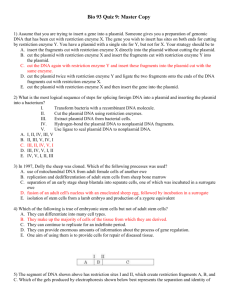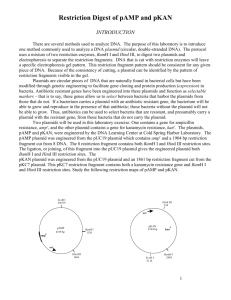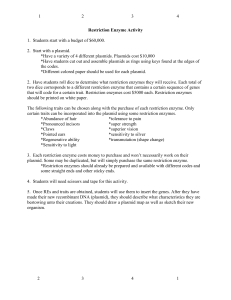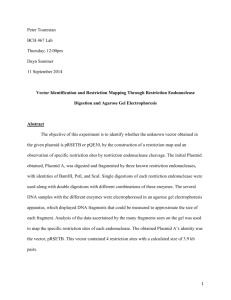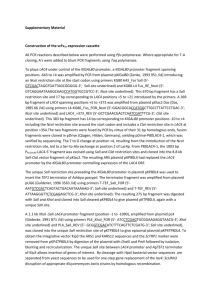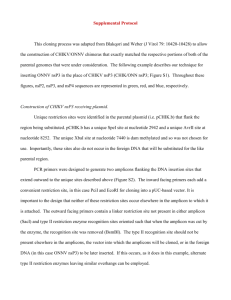Plasmid identification
advertisement
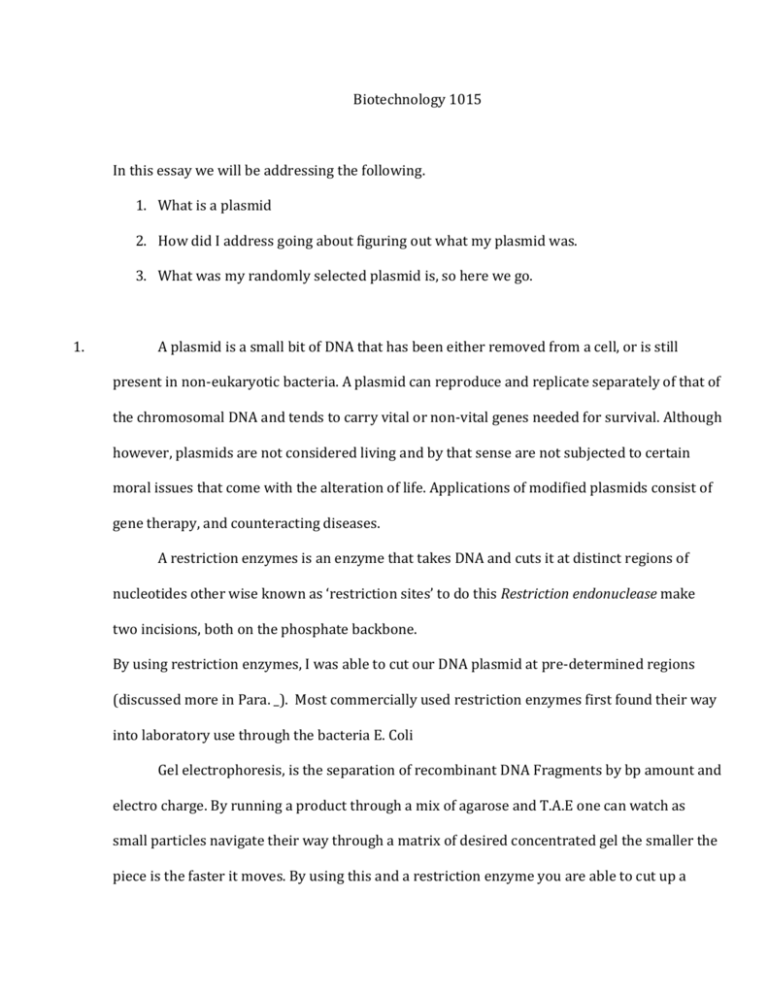
Biotechnology 1015 In this essay we will be addressing the following. 1. What is a plasmid 2. How did I address going about figuring out what my plasmid was. 3. What was my randomly selected plasmid is, so here we go. 1. A plasmid is a small bit of DNA that has been either removed from a cell, or is still present in non-eukaryotic bacteria. A plasmid can reproduce and replicate separately of that of the chromosomal DNA and tends to carry vital or non-vital genes needed for survival. Although however, plasmids are not considered living and by that sense are not subjected to certain moral issues that come with the alteration of life. Applications of modified plasmids consist of gene therapy, and counteracting diseases. A restriction enzymes is an enzyme that takes DNA and cuts it at distinct regions of nucleotides other wise known as ‘restriction sites’ to do this Restriction endonuclease make two incisions, both on the phosphate backbone. By using restriction enzymes, I was able to cut our DNA plasmid at pre-determined regions (discussed more in Para. _). Most commercially used restriction enzymes first found their way into laboratory use through the bacteria E. Coli Gel electrophoresis, is the separation of recombinant DNA Fragments by bp amount and electro charge. By running a product through a mix of agarose and T.A.E one can watch as small particles navigate their way through a matrix of desired concentrated gel the smaller the piece is the faster it moves. By using this and a restriction enzyme you are able to cut up a piece of DNA and separate the fragments by bp (base pair) size. Gel electrophoresis is used in almost every laboratory that uses DNA applications, including but not limited to Forensics, Molecular biology, and genetics. During this procedure we were presented a first time look at real world applications of modern day biotechnology. We tested our developed and acquired skills with pipetting and understanding of lab protocol as well as molecular biology. In this lab we were given on of three random plasmids; pAMP, pKAN, or pBLU. Using nothing but the assistance of prior procedures we began testing suitable restriction digests and were told too uncover the random plasmid were given. “Here’s DNA tell me what it is.” The topic of this paper is the importance of correct lab procedures during an exercise such as plasmid identification. Lab procedures play the utmost critical role in whether or not an individual can preform a task presented. Improper lab procedures can lead to catastrophic consequences and complete inaccuracy of results. In this experiment we were testing for the first time our understanding of pipetting, instrument use, proper dilution, and molecular concentrations. So to uncover this, I decided to use several chosen restriction enzymes, digest my selected DNA, and uncover the remaining fragment sizes. I then compared these to the expected results of already determined fragment sizes and was awarded my answer. 2. In this project, we were provided with a random sample plasmid, mine had the code 2110a29. This is the code that provides the instructor with the information on whether or not my results were accurate by telling him the identity of my DNA Another important aspect on this lab is concentration amounts, Which were also provided by the instructor. Although the problem came when we were asked to dilute the stock solution that was at 500ng/ul to the desired concentration was 150 NG/UL. After figuring out the required amount plasmid required in a 20ul solution we then added our restriction enzymes. These products are NEB-Pstl, Ndel, puvl as well as a 3.1buffer We made three total solutions using the following websites to assist in the procurement and compatibility; tinyurl.com/plasmidseq, tinyurl.com/NEBcutter, tinyurl.com/nebbuffers, tinyurl.com/nebdoubledigest, we retrieved the following enzymes1. NDEL+PSTL 2. PVUL 3. Nothing. We let these digest awhile (60 minutes at 37.5 Celsius) then moved into making a .08%-.46g/60ml agarose gel with 60ml of 1xTAE (made from a stock solution of 10x TAE with 29.2gtris/2.86ml glacial acidic acid/. 73gEDTA). depending on the thickness of your gel controls the recommended BP size put into it. Although in our situation .08% was universally recommended. We then microwaved this and added 1-2ul of ethidium bromide (the DNA identifier) Later in our lab during the electrophoresis portion, where we were self tasked into determining the size of our fragments, we Dyed our enzymes with a total of 4UL of 6x loading dye, we then used a ladder to compare our fragment sizes with, a ladder is a set of already determined BP fragment sizes that we then compared with our fragment sizes to the NEB (New England Biolab) 1k ladder. After adding the ladder to the gel, we then added our DNA in descending order. After letting it run for 45 minutes at 140v we removed the gel from the electrophoresis chamber, and using UV lighting to highlight the ethidium bromide attached to base pairs we identified the Plasmid to be pAMP Using an exponential line of best fit curve (Microsoft excel) along with a 1k NEB ladder. 3. The 500NG/UL concentration of DNA has led me into all sorts of riotous fun Ladder double single control ladder figure 1.1 FRAGMENT SIZES figure 1.2 PST1+NDEL PVUL pAMP 3134, 1405, 3643, 896 pKAN 2635, 973, 636 3622, 572, pBLU 2998, 1316, 926, 197 1980, 1798, 726, 480, 453 Figure 1.3 All this and more has lead to me the conclusion that my randomly selected plasmid is pAMP, because if you look at figure 1.3, the double digest fragment sizes for pAMP barely match with - -the indicated results on the last two rows of figure 1.2 where if you look at the single digest on figure 1.2, the last two almost match perfectly with the expected fragment sizes Credits due too, Professor: Richard Scott Final conclusion: pAMP. Cameron Miller May 04 2014 P.S No Works Cited.






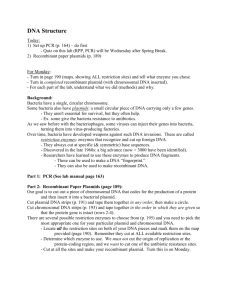

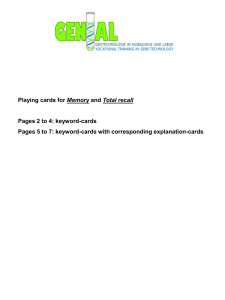
![Student Objectives [PA Standards]](http://s3.studylib.net/store/data/006630549_1-750e3ff6182968404793bd7a6bb8de86-300x300.png)
